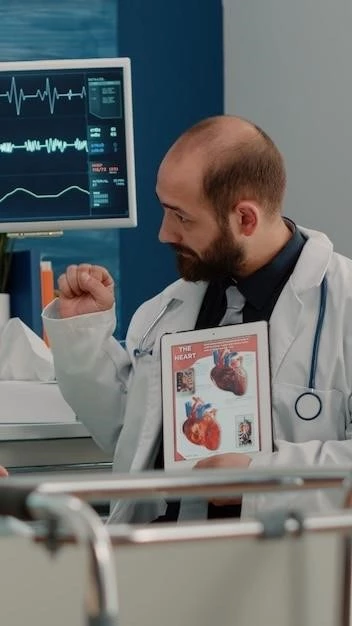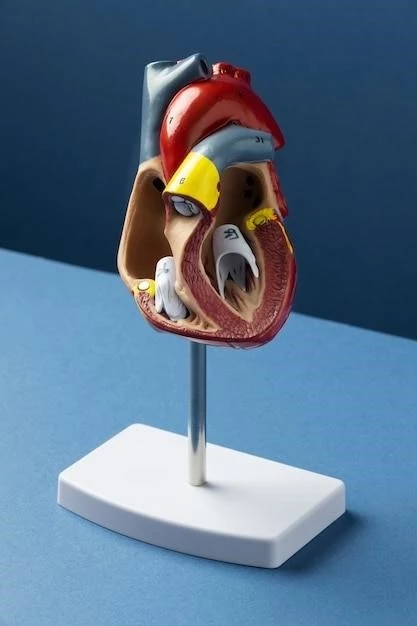Double Outlet Right Ventricle
Double Outlet Right Ventricle (DORV) is a congenital heart defect characterized by abnormal heart development․ This article aims to explore the understanding of heart conditions, anatomy of the heart in DORV, specific defects, treatment options, specialized care in pediatric cardiology, maintaining heart health, and a conclusion․
Introduction to Double Outlet Right Ventricle
Double Outlet Right Ventricle (DORV) is a complex congenital heart defect where the aorta and pulmonary artery both connect to the right ventricle; This condition leads to mixing of oxygen-rich and oxygen-poor blood, affecting heart function․ DORV usually involves a ventricular septal defect (VSD), where there is an abnormal opening between the heart chambers․
Individuals with DORV may experience various cardiac abnormalities, impacting their overall health․ The diagnosis of DORV often requires specialized imaging studies and consultation with pediatric cardiology experts․ Understanding the specific abnormalities and how they affect the heart’s function is crucial for determining the most appropriate treatment approach․
While DORV is a complex condition, advancements in cardiology and heart surgery have significantly improved the outcomes for patients with this congenital heart defect․ Timely medical treatment and ongoing care by heart specialists are essential to manage DORV effectively and ensure optimal heart health․ This article delves into the intricacies of DORV, providing insights into its anatomy, defects, treatment options, and the specialized care required for individuals with this condition․
Understanding Heart Conditions
Heart conditions encompass a wide range of abnormalities affecting the structure and function of the heart․ These conditions can be acquired or congenital, like Double Outlet Right Ventricle (DORV)․ Congenital heart defects, such as DORV, involve anomalies present at birth that influence how blood flows through the heart and the body․
Abnormal heart development can lead to various cardiac abnormalities, impacting the heart chambers, vessels like the aorta and pulmonary artery, and other critical structures․ Understanding these abnormalities is vital in diagnosing and managing conditions like DORV effectively․ Cardiology, as a specialized field focusing on heart health, plays a crucial role in identifying, treating, and monitoring heart diseases․
Advancements in pediatric cardiology have improved the understanding of heart conditions and the development of innovative treatment options․ Heart specialists work tirelessly to enhance outcomes for patients with complex conditions like DORV, ensuring that individuals receive comprehensive care tailored to their unique needs․
By comprehensively understanding heart conditions and the underlying mechanisms that contribute to abnormalities like those seen in DORV, medical professionals can tailor treatment plans to address each patient’s specific needs․ Through ongoing research and collaboration among experts in the field of cardiology, the prognosis for individuals with congenital heart defects continues to improve, offering hope for better outcomes and enhanced quality of life․
Anatomy of the Heart in DORV
In Double Outlet Right Ventricle (DORV), the heart’s anatomy is altered compared to a normal heart․ In DORV, both the aorta and pulmonary artery arise from the right ventricle, leading to a mixing of oxygen-rich and oxygen-poor blood․ This abnormal positioning of the major arteries affects the circulation of blood throughout the body․
Typically, the aorta should arise from the left ventricle, carrying oxygen-rich blood to the body, and the pulmonary artery should arise from the right ventricle, carrying oxygen-poor blood to the lungs․ However, in DORV, both vessels come from the right ventricle, resulting in decreased oxygenation of blood and added strain on the heart․
Additionally, individuals with DORV often have a ventricular septal defect (VSD), an abnormal opening between the ventricles of the heart․ This defect allows further mixing of oxygen-rich and oxygen-poor blood, complicating the heart’s ability to pump blood effectively to meet the body’s demands․
Understanding the intricate anatomy of the heart in DORV is crucial for both diagnosis and treatment planning․ Cardiologists and pediatric cardiology specialists utilize advanced imaging techniques to visualize these structural abnormalities and formulate comprehensive treatment strategies to address the complex challenges presented by DORV․
Specific Defects in DORV
Double Outlet Right Ventricle (DORV) is associated with specific defects that impact the heart’s structure and function․ One of the primary defects in DORV is the abnormal connection of both the aorta and pulmonary artery to the right ventricle, leading to a mixing of oxygen-rich and oxygen-poor blood․
Individuals with DORV often present with a ventricular septal defect (VSD), a hole in the wall that separates the heart’s ventricles․ This VSD further exacerbates the mixing of blood and affects the heart’s ability to efficiently pump oxygenated blood to the body․
Moreover, DORV may involve other defects such as abnormalities in the heart valves or the vessels that carry blood to and from the heart․ These additional complications can contribute to the overall complexity of the condition and may require specialized interventions to optimize heart function․
Given the array of specific defects associated with DORV, a comprehensive evaluation by pediatric cardiologists and heart specialists is essential for accurate diagnosis and tailored treatment planning․ Addressing each defect and its implications is crucial in providing personalized care to individuals with this congenital heart condition․
Treatment Options for DORV
Managing Double Outlet Right Ventricle (DORV) often requires a multidisciplinary approach involving pediatric cardiologists, cardiac surgeons, and other healthcare specialists․ The treatment options for DORV depend on the specific defects present, the individual’s overall health, and the severity of the condition․
Surgical interventions are commonly required to correct the structural abnormalities associated with DORV․ Procedures may include repairing the ventricular septal defect (VSD), relocating the aorta to the left ventricle, and ensuring the proper connection of the pulmonary artery․ These surgeries aim to improve blood flow, reduce mixing of oxygen-rich and oxygen-poor blood, and optimize heart function․

In some cases, individuals with DORV may need multiple surgeries over their lifetime to address complications or progression of the condition․ Close monitoring by pediatric cardiology specialists is necessary to assess the effectiveness of treatment, identify any recurrent defects, and ensure ongoing heart health․
Medical management, including medications to support heart function and manage symptoms, may also be part of the treatment plan for individuals with DORV․ Regular follow-up appointments with healthcare providers specializing in cardiology are essential to monitor the heart’s function, assess any changes in the condition, and adjust treatment strategies accordingly․
Overall, the comprehensive care provided by a coordinated team of heart specialists is essential in managing DORV effectively and improving the long-term outcomes for individuals living with this complex congenital heart condition․
Specialized Care in Pediatric Cardiology
Specialized care in pediatric cardiology is paramount in the management of complex congenital heart conditions such as Double Outlet Right Ventricle (DORV)․ Pediatric cardiologists are highly trained professionals with expertise in diagnosing and treating heart diseases in infants, children, and adolescents․
Individuals with DORV require specialized attention from pediatric cardiology experts who understand the unique challenges associated with this condition․ These specialists conduct thorough evaluations, including advanced imaging studies, to assess the heart’s structure and function accurately․
Collaboration between pediatric cardiologists, cardiac surgeons, and other healthcare professionals is essential in developing personalized treatment plans for patients with DORV․ This collaborative approach ensures that individuals receive comprehensive care tailored to their specific needs and promotes the best possible outcomes․
Regular follow-up appointments with pediatric cardiology specialists are crucial to monitor heart function, assess the effectiveness of treatment, and address any concerns or complications promptly․ The expertise and dedication of these healthcare providers play a pivotal role in optimizing heart health and quality of life for individuals living with DORV․
By entrusting their care to specialized pediatric cardiology teams, individuals with DORV can benefit from individualized treatment strategies, ongoing support, and access to the latest advancements in heart health management․ The commitment of pediatric cardiology experts ensures that patients receive the highest standard of care for their complex heart condition․
Maintaining Heart Health with DORV
Individuals with Double Outlet Right Ventricle (DORV) can take proactive steps to maintain their heart health and overall well-being․ Regular follow-up care with pediatric cardiology specialists is essential to monitor the heart’s function, assess the effectiveness of treatments, and address any emerging issues promptly․
Adopting a heart-healthy lifestyle can have a positive impact on managing DORV․ This includes maintaining a balanced diet low in saturated fats and cholesterol, engaging in regular physical activity as recommended by healthcare providers, avoiding tobacco and excessive alcohol consumption, and managing stress effectively․
Individuals with DORV should be diligent about taking medications as prescribed by their healthcare team to support heart function, control blood pressure, and manage any associated symptoms․ Compliance with medication regimens and attending scheduled appointments are crucial for optimizing treatment outcomes․
Educating oneself about DORV, understanding the specific defects and treatment options, and actively participating in healthcare decisions can empower individuals with this condition to advocate for their own heart health․ Seeking support from healthcare professionals, support groups, and loved ones can also be beneficial in managing the challenges associated with DORV․
By prioritizing heart health through lifestyle modifications, medication adherence, regular monitoring, and active involvement in care, individuals with DORV can enhance their quality of life and promote long-term cardiac well-being․ The dedication to maintaining heart health is a collaborative effort between patients, healthcare providers, and support systems, all working towards the common goal of optimal heart function and overall health․
Conclusion
In conclusion, Double Outlet Right Ventricle (DORV) is a complex congenital heart defect that requires specialized care and attention from pediatric cardiology experts․ Understanding the anatomy, specific defects, and treatment options associated with DORV is essential in providing comprehensive care to individuals affected by this condition․
Through advancements in cardiology and heart surgery, significant progress has been made in the diagnosis and management of DORV, leading to improved outcomes and quality of life for patients․ The collaborative efforts of pediatric cardiologists, cardiac surgeons, and other healthcare professionals play a crucial role in delivering personalized treatment plans and ongoing support to individuals with DORV;
Maintaining heart health with DORV involves a multi-faceted approach, encompassing regular monitoring, lifestyle modifications, adherence to medical interventions, and active participation in healthcare decisions․ By prioritizing heart-healthy practices and seeking specialized care, individuals with DORV can navigate the challenges of this condition and promote their long-term well-being․
Overall, the dedication of healthcare providers, the resilience of patients, and the support of families and caregivers contribute to a comprehensive framework for managing DORV effectively․ By raising awareness, promoting education, and advocating for continued research in the field of pediatric cardiology, we can strive towards better outcomes and improved quality of life for individuals living with DORV․
